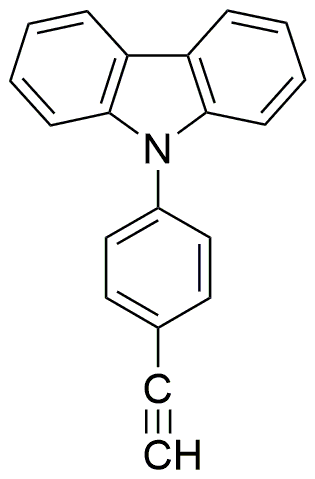9-(4-Ethynylphenyl)carbazole is widely utilized in research focused on:
- Organic Electronics: This compound is a key material in the development of organic light-emitting diodes (OLEDs), which are used in displays and lighting. Its unique properties enhance efficiency and color purity.
- Photovoltaics: It serves as a promising component in organic solar cells, improving energy conversion efficiency. This application is crucial for advancing renewable energy technologies.
- Fluorescent Sensors: The compound is used in creating sensors for detecting environmental pollutants. Its fluorescence properties allow for sensitive and selective detection, making it valuable in environmental monitoring.
- Polymer Science: It acts as a building block for synthesizing new polymers with tailored electronic properties, which can be applied in various fields, including coatings and adhesives.
- Research in Photonics: This chemical is explored in the field of photonics for its ability to manipulate light, which can lead to advancements in optical devices and communication technologies.
Información general
Propiedades
Seguridad y normativas
Aplicaciones
9-(4-Ethynylphenyl)carbazole is widely utilized in research focused on:
- Organic Electronics: This compound is a key material in the development of organic light-emitting diodes (OLEDs), which are used in displays and lighting. Its unique properties enhance efficiency and color purity.
- Photovoltaics: It serves as a promising component in organic solar cells, improving energy conversion efficiency. This application is crucial for advancing renewable energy technologies.
- Fluorescent Sensors: The compound is used in creating sensors for detecting environmental pollutants. Its fluorescence properties allow for sensitive and selective detection, making it valuable in environmental monitoring.
- Polymer Science: It acts as a building block for synthesizing new polymers with tailored electronic properties, which can be applied in various fields, including coatings and adhesives.
- Research in Photonics: This chemical is explored in the field of photonics for its ability to manipulate light, which can lead to advancements in optical devices and communication technologies.
Documentos
Hojas de datos de seguridad (HDS)
La SDS proporciona información de seguridad completa sobre la manipulación, el almacenamiento y la eliminación del producto.
Especificación del producto (PS)
La PS proporciona un desglose completo de las propiedades del producto, incluida la composición química, el estado físico, la pureza y los requisitos de almacenamiento. También detalla los rangos de calidad aceptables y las aplicaciones previstas del producto.
Certificados de análisis (COA)
Busque certificados de análisis (COA) ingresando el número de lote del producto. Los números de lote y de partida se pueden encontrar en la etiqueta de un producto después de las palabras "Lote" o "Lote".
Número de catálogo
Número de lote/lote
Certificados de origen (COO)
Este certificado de origen confirma el país en el que se fabricó el producto y también detalla los materiales y componentes utilizados en él y si se deriva de fuentes naturales, sintéticas u otras fuentes específicas. Este certificado puede ser necesario para cumplir con las normativas aduaneras, comerciales y regulatorias.
Número de catálogo
Número de lote/lote
Hojas de datos de seguridad (HDS)
La SDS proporciona información de seguridad completa sobre la manipulación, el almacenamiento y la eliminación del producto.
DownloadEspecificación del producto (PS)
La PS proporciona un desglose completo de las propiedades del producto, incluida la composición química, el estado físico, la pureza y los requisitos de almacenamiento. También detalla los rangos de calidad aceptables y las aplicaciones previstas del producto.
DownloadCertificados de análisis (COA)
Busque certificados de análisis (COA) ingresando el número de lote del producto. Los números de lote y de partida se pueden encontrar en la etiqueta de un producto después de las palabras "Lote" o "Lote".
Número de catálogo
Número de lote/lote
Certificados de origen (COO)
Este certificado de origen confirma el país en el que se fabricó el producto y también detalla los materiales y componentes utilizados en él y si se deriva de fuentes naturales, sintéticas u otras fuentes específicas. Este certificado puede ser necesario para cumplir con las normativas aduaneras, comerciales y regulatorias.


